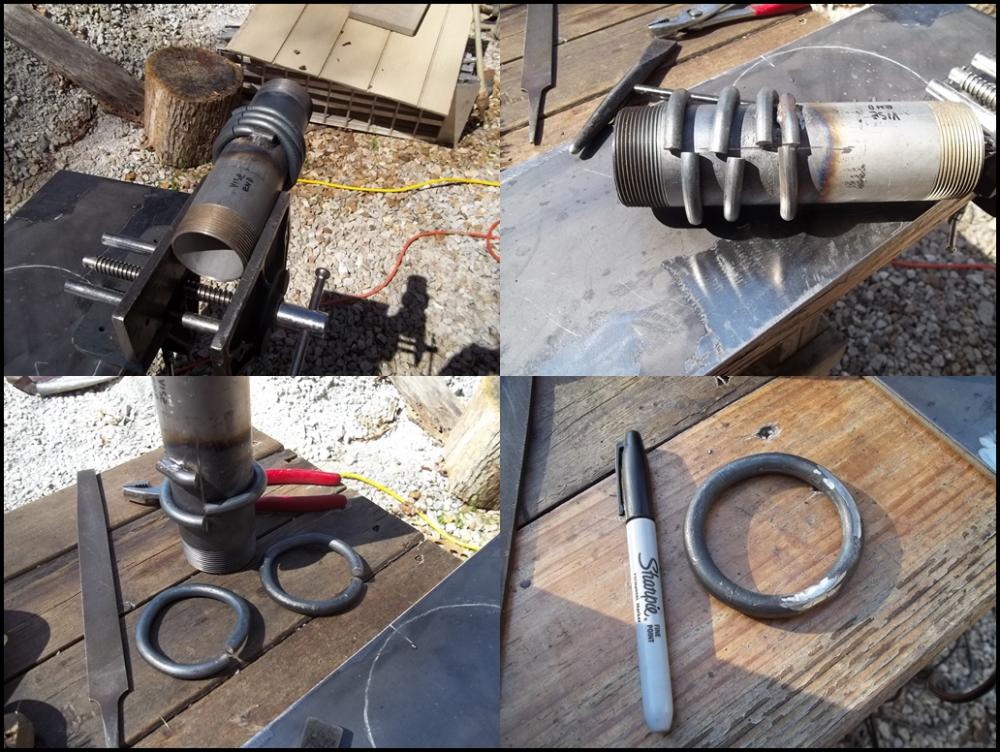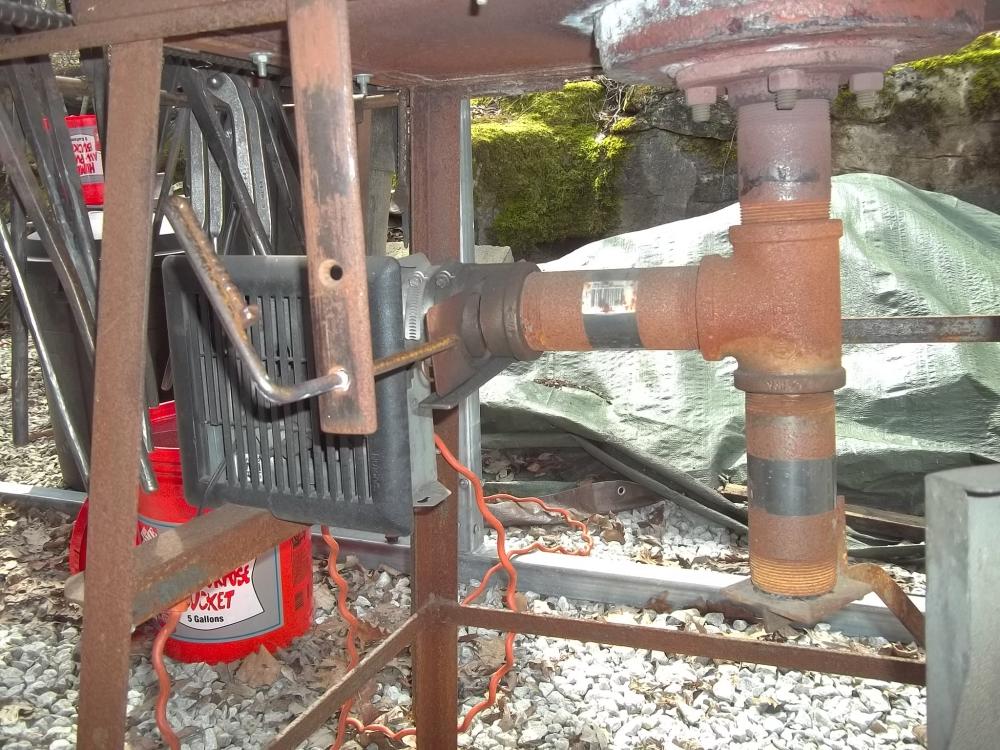-
Posts
2,679 -
Joined
-
Last visited
Content Type
Profiles
Forums
Articles
Gallery
Downloads
Events
Everything posted by arkie
-

Good Deal on Wrought Iron?
arkie replied to Forging Carver's topic in Blacksmithing, General Discussion
Carver, you have a PM -
Get Richard Postman's book, Mousehole Forge. Fascinating reading. Covers the Armitage era.
-
Look up "Old Globe Reclaimed Wood" on the entrynet, then go to "Other Products" and also the "Contact" info. I bought some wrought iron rod from them a year or so ago. I don't know if they are still selling any wrought iron these days. BTW, the history of the Old Globe grain storage facility is interesting reading anyway. Google it.
-
I think Glenn has a valid point. 'Jus my 2c worth...
-
And they say multi-tasking is for the tech age........
-
Vaughn, you'll find that the more common rods (6010, 6011, 6013, 7014, 7018) run best on DCEP, but the 6011's will run equally well on AC. For lower penetration run the 6013's on DCEN. Drag rods are usually 6013, 7014 and 7018 or maybe run with a very tight arc. Your beads are coming along. The explosion at the end of one bead may have been long arcing.
-
Well, at least you won't poke a hole in your hat or coat collar when you hang them up!
-
Nice forge, I think you'll enjoy it. If I may make one suggestion...the pipe from your blower to the vertical pipe is at an upward angle. As ash forms, you will find that a significant amount will find it's way "down slope" into your fan. Not necessarily when the blower is going, but when you shut it off and when cleaning out your tuyere and firepot. Best to have the pipe from the fan at a right angle to the vertical one. Plenty of air flow will get to the firepot at right angles, no need to direct it with an upward pipe.
-
Nice work with the coins. What kind/size of billet did you hammer them into? Unfortunately, these days, they don't have any metal of value in them, only the denomination stamped on the surface.
-
OK, thanks for the information. I'll look into it. The flip-ups would be better for me.
-
I don't see a problem with answering a question such as a date request. Posting copyrighted content is another matter and is prohibited. Copying his list of serial numbers would be prohibited. Probably a great amount of information disseminated here is passed-on information related what someone read or heard from some other copyrighted material, but not reproducing or copying it. Many posts have been made wherein someone asked for a date and received it. As for Postman's book, Anvils In America, I highly recommend you get a copy from the library or purchase a copy. It is fascinating reading and you can learn a lot about anvil manufacturing. His companion book, Mousehole Forge, is likewise fascinating reading, even for one like myself who is not a history buff. It makes one more appreciative of the old anvils we use. I recommend it highly as well.
-
Very nice anvil! If the serial number were only "8075" without any letters, it would be dated 1899. Postman didn't list any letter prefixes or suffixes in his list of serial numbers. Maybe some Trenton experts could lend additional information. Maybe you could dust with flour or try different lighting to see if the "A"'s might be "4"'s.
-
Doug, you have a valid point there....about the bend.
-
Quench, some blowers work best when the air supply is regulated on the fan exhaust, others will work OK with the air supply regulated on the intake. Restricting air on the intake may cause some motors to not be sufficiently cooled and thereby overheat. Big question is....how does one determine if a blower/motor will overheat if the intake is restricted...with so many of us using repurposed blowers??????? Probably only if you buy one new and the manufacturer specifies the parameters. CAE, you're making good progress. It doesn't come overnight! I've modified my forge several times and am about to make a new hood. The first one was made from sheet metal that was too thin. Next one will be heavier.
-
I would certainly make the holes before bending the rod, as it would be more difficult to balance a long, curved rod on your anvil than a straight one. That's not a strong bend. I suppose you could use a hold-down and/or brace if you punched a curved rod.
-
Here are some photos of rings I made sometime back using the technique that anvil described. I cut mine with an angle grinder and 1/16" cutoff wheel. I believe my rings were 3/8" HR rod.
-
Eric, good news that your flip-ups are IR filtered. Would you mind telling the brand, style and where you got them?
-
That might be worth a try. You will have to place a grid, plate, cast iron grate or something on top of the pipe and filler, maybe covering the entire diameter of the drum to keep things from moving around when you tend the fire. Perlite would probably burn up. Sand might be a usable filler, or refractory clay, it might not get hot enough to melt (the sand)...just have to try what works. I know that my 1/2" bar steel grid gets red hot sometimes with heavy forging. Maybe someone has a suggestion for an annulus filler that would work.
-
As Thomas Powers pointed out earlier in this thread..." Forge doesn't put out ultraviolet; arc welding does." That includes, MIG, TIG, stick and others. Shade 3 welding glasses (and any welding PPE optics) are primarily for UV shielding, not IR. Search the UVEX site (probably one of the most comprehensive industrial optics companies) for IR shielded glasses or goggles...there are very few. Make sure that if you want IR protection, it is clearly specified in the product.
-
Lost post again... CAE, your blast gate looks like it will work ok. I open mine only about 1/4 to 1/2 for most forging, rarely wide open. My opinion, for what it's worth, is that your drum is too deep. You might find a fix like claying, firebrick, etc. to raise the bottom, but instead you might consider finding a regular automobile drum which would be shallower, around 2" or so. With that deep drum you are just going to be wasting a lot of coal, and the rice size will burn fast. Maybe try nut size or slightly larger. Glenn's suggestion about piling up the coal is a good one. I usually mound my coal up about 3-4" deep over the firepot. Here are some pics of my drum during installing a grating in the bottom. It's not nearly as deep as yours.
-
CAE, I simply sawed the black pipe connector starting with a hacksaw to get going. I found a piece of scrap sheet metal the same thickness as my sawzall blades. I completed the cuts with the sawzall...much easier than the hacksaw. If you find sheet metal the same thickness as a hacksaw blade, it bends too easily when you slide it back and forth. If you wanted to use a thicker sliding gate, the slots could be cut with a angle grinder and cutoff disk. Here's a pic of the plumbing installed. The ash dump is simple to make; like the exhaust cap on a truck. My first fart fan lasted 3 years and quit when one of the wires broke off inside the motor. Replaced it with another...$17 at HD.
-
Wetting the coal is OK, just don't pour water on your cast iron firepot or it'll crack like crazy. Your brake drum is fine as far as depth goes. I use one all the time and the depth is not an issue. You don't necessarily want it too shallow or you'll be heating your work down in an oxygen-rich zone...more scale and oxidation. Glenn had posted a great graphic on the forum showing an optimum firepot arrangement. Search the forum to find it.
-
kyaw, I wouldn't worry about the holes. Most times, a "repair" to a functional anvil does more harm than good. Leave it as is. Sounds like you got good rebound. Put that anvil to work!
-
CAE, welcome to the forum. To regulate your air supply, a blast gate (air gate) is a good way to regulate your air flow when you don't have a variable blower. That way you can manage your fuel and choke it down when you don't need a hot fire. You'll need to pile up your coal to build up a good "fire ball" in which to put your work piece. If your fire gets too hot or too big for you, just throttle back on the air. Anthracite doesn't have as much in the way of impurities as bituminous, so you'll not get the coke like the soft coal. It'll still forge just fine. Lots of folks use hair dryers, but I find them too loud and irritating. I use a fart fan, others use blowers from cars, clothes dryers, hand crank blowers, etc. whatever you can find. Here's a blast gate I made for my forge. Just cut a slot in a pipe connector and use sheet metal for the sliding gate. (I've since added an ash dump which you will find handy).


